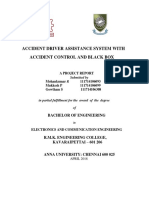Final Report Format2
Uploaded by
aswathy_menon_4Final Report Format2
Uploaded by
aswathy_menon_4BLACK BOX REPORT 11
PROJECT
INTRODUCTION
1.1 INTRODUCTION
Dept. of ECE
VAST
BLACK BOX REPORT 11
PROJECT
In our daily life, we come across numerous accidents in our roads which results in countless casualties and even death of many. We live in a nation where road accident has been turned to be an obligation in the day-to-day traffic life. Human factors in vehicle collisions include all factors related to drivers and other road users that may contribute to a collision. Examples include driver behavior, visual and auditory acuity, decision-making ability, and reaction speed. But in many of these cases, the soul reason for the accident to take place continues to be a mystery, or the reason behind the accident may be interpreted and concluded wrongly. It would be a remarkable achievement in this field, if we could find an alternative, to get to the actual soul reasons for the cause of an accident rather than by attempting to come into a conclusion from on field tests and studying, which may result in a waste of lots of time, and might end up in giving insufficient or no result at all. As already mentioned, the alarming rate of the road accidents all over the world is a serious cause of worry. This reasoning which helps us to learn about the actual causes of accidents could help us to decrease it marginally. These causes could be studied and analyzed and then finally needed steps could be undertaken, so as to decrease or even eliminate the chances of them to occur again, like by enforcing new traffic rules, by adding additional safety measures to the vehicles etc. In this venture of ours, THE BLACK BOX we implement different units to facilitate this procedure of reasoning a cause of traffic accidents, like sensors to check different parameters such as speed of the vehicle, alcohol consumption of the driver and the temperature of the engine. What we aim to implement here is designing of a device which keeps track of the conditions of the vehicle. LEARNING ABOUT THE CAUSE OF AN ACCIDENT MAY NOT BRING BACK THE PRECIOUS LIVES OF THE PEOPLE WHOM WE LOST, BUT IT COULD AID US IN SAVING LIVES OF MANY MORE PEOPLE.
1.2 OBJECTIVE
Dept. of ECE
VAST
BLACK BOX REPORT 11
PROJECT
The soul objective of our project could be summarised as an effort to create an automobile black box which aims at recording the activities of the automobile thus aiding in creation of an easier mechanism to find the actual cause of accidents. It could be a remarkable step in the field of traffic engineering as it could help in knowing the causes of an accident and thus aid in largely decreasing the same. The components of an automobile black box could be short listed as a PIC microcontroller, a collision sensor, a temperature sensor, a speed sensor and finally a LCD display. PIC is a 16-bit microcontroller that controls and interfaces all the devices required for its working; a collision sensor is a switch which senses the occurrence of a collision to the vehicle; temperature sensor is an IC-LM 35 to sense the temperature of the engine; speed sensor may aid to govern the speed of the vehicle; alcohol sensor inquires the presence of alcohol consumption of the driver using and the LCD screen displays the required result on its screen. We pre program the PIC microcontroller [16F877A] using Embedded C. This venture could be of great help in this field as it could lead and help to decrease the possibility of occurring accidents thus making its application sound in every corner of this world. This could be easily incorporated and made to work with comparatively less cost and could be easily improvised with additional features without much effort.
1.3 BLOCK DIAGRAM
Dept. of ECE
VAST
BLACK BOX REPORT 11
PROJECT
Temperature sensor
LCD Display
Speed sensor
Microcontroller
Alcohol sensor
Alcohol Amplifier sensor
Fig (1) : Block diagram of Black Box
Dept. of ECE
VAST
BLACK BOX REPORT 11
PROJECT
SYSTEM DESIGN
2.1 BLOCK DIAGRAM DESCRIPTION:
TEMPERATURE SENSOR:
Dept. of ECE
VAST
BLACK BOX REPORT 11
PROJECT
The temperature sensor senses the temperature of the vehicle while it is in motion. The temperature sensor used here is LM35. The LM35 series are precision integrated-circuit temperature sensors, whose output voltage is linearly proportional to the Celsius (Centigrade) temperature. The LM35 thus has an advantage over linear temperature sensors calibrated in Kelvin, as the user is not required to subtract a large constant voltage from its output to obtain convenient Centigrade scaling. The LM35 does not require any external calibration or trimming to provide typical accuracies of 14C at room temperature and 34C over a full 55 to +150C temperature range. Low cost is assured by trimming and calibration at the wafer level. The LM35s low output impedance, linear output, and precise inherent calibration make interfacing to readout or control circuitry especially easy. It can be used with single power supplies, or with plus and minus supplies. The LM35 is rated to operate over a 55 to +150C temperature range, while the LM35C is rated for a 40 to +110C range (10 with improved accuracy).
Features
Calibrated directly in Celsius (Centigrade) Linear + 10.0 mV/C scale factor 0.5C accuracy guaranteeable (at +25C) Rated for full 55 to +150C range Suitable for remote applications Low cost due to wafer-level trimming Operates from 4 to 30 volts Less than 60 A current drain Low self-heating, 0.08C in still air Nonlinearity only 14C typical Low impedance output, 0.1 W for 1 mA load
Dept. of ECE
VAST
BLACK BOX REPORT 11
PROJECT
ALCOHOL SENSOR: The alcohol sensor senses whether the driver has consumed alcohol or not. The sensor used here is MQ3. This alcohol sensor is suitable for detecting alcohol concentration on your breath, just like the common breathalyzer. It has high sensitivity to alcohol and fast response time. Sensor provides an analog resistive output based on alcohol concentration. The drive circuit is very simple; all it needs is one resistor. A simple interface could be a 0-3.3V ADC.
Features:
Dept. of ECE
VAST
BLACK BOX REPORT 11
PROJECT
Requires heater voltage Operation Temperature: -10 to 70 degrees C Heater consumption: less than 750mW
Dimensions:
16.8mm diameter 9.3 mm height without the pins
SPEED SENSOR The speed sensor determines the speed of the vehicle. The speed at the instant when the collision took place is displayed on the LCD display. The speed sensor consists of a propeller fan and a dc generator. LCD DISPLAY The LCD display displays the values of the speed and temperature when a collision is sensed. It also displays whether the driver has consumed alcohol and the levels of consumption like Low, Medium and High. The LCD display used here is 16X2 LCD display. This is a high quality 16 character by 2 line intelligent display module, with back lighting, Works with almost any microcontroller.
Features
Dept. of ECE
VAST
BLACK BOX REPORT 11
PROJECT
16 Characters x 2 Lines 5x7 Dot Matrix Character + Cursor HD44780 Equivalent LCD Controller/driver Built-In 4-bit or 8-bit MPU Interface Standard Type Works with almost any Microcontroller Great Value Pricing
The pin outs are as follows: 1. 2. 3. 4. 5. 6. 7. 8. 9. 10. 11. 12. 13. 14. 15. 16. Ground VCC (+3.3 to +5V) Contrast adjustment (VO) Register Select (RS). RS=0: Command, RS=1: Data Read/Write (R/W). R/W=0: Write, R/W=1: Read Clock (Enable). Falling edge triggered Bit 0 (Not used in 4-bit operation) Bit 1 (Not used in 4-bit operation) Bit 2 (Not used in 4-bit operation) Bit 3 (Not used in 4-bit operation) Bit 4 Bit 5 Bit 6 Bit 7 Backlight Anode (+) Backlight Cathode (-)
2.2 WORKING
Dept. of ECE
VAST
BLACK BOX REPORT 11
PROJECT
The black box consists of the temperature, speed and alcohol sensors, a microcontroller and an LCD display. Here PIC16F877A microcontroller controls the entire operation of this system. PIC is Peripheral Interface Controller, which is a 40 pin DIP IC. It works at a voltage of 4.5-5V. The clock required is applied to pins 13 and 14 using crystal oscillator. It has 5 ports, namely A, B, C, D and E where A is 16 bit, E is 3bits and ports B through D are of 8bits each. The collision of the vehicle is sensed using a collision sensor. A switch is used to detect collision. A sensor is placed each on the front and rear part of the vehicle. One terminal of the switch is connected to the Vcc and the other is connected to the A2 pin of the PIC. Normally, the voltage on the A2 pin is low. When a collision takes place, the two terminals of the switch get shorted and the voltage Vcc appears on the output pin of the PIC. Thus, a collision is sensed. The speed sensor determines the speed of the vehicle and stores the value in the memory of the microcontroller when a collision takes place. The main component of the speed sensor is a DC generator which is connected to the propeller of the engine of the vehicle. When the vehicle moves, the propeller rotates. As a result, a DC voltage is developed in the generator. As the speed of the vehicle changes, the speed of the rotation of the generator changes linearly, thereby changing the dc voltage developed across it. This DC voltage, which is analog in nature, is applied to the ADC pin of the PIC. Thus, we get a digital value corresponding to the speed of the vehicle. This value of speed is displayed on an LCD display when a collision is sensed. The alcohol sensor is used to detect whether the driver has consumed alcohol or not. The sensor used here is MQ3 Gas Sensor. A coil and a gas sensor are present in the sensor. The alcohol sensing element works only when the coil is heated. This sensor has 6 terminals, namely A, B and H, two each. The A and B terminals are interchangeable. Either of the A or B terminals are shorted together and connected to Vcc. One of the H terminals is also connected to the Vcc and the other is grounded. The output appears across the other shorted terminal and the ground. This terminal is
Dept. of ECE
10
VAST
BLACK BOX REPORT 11
PROJECT
connected to the ADC pin of the PIC through a load resistor. A DC voltage proportional to the alcohol content is developed at the output of the sensor. This analog output is converted to digital form by connecting it to the ADC pins of the PIC. The PIC is programmed so that it displays messages on the LCD according to the amount of consumption. The temperature sensor determines the temperature of the vehicle. The IC LM35 Precision Centigrade Temperature Sensor is used to sense the temperature. Temperatures ranging from 0C to 100C can be measured using this sensor. Its precision is 1. The Vcc terminal is connected to +5V. The output pin is connected to the Ao pin of the PIC. When the temperature of the vehicle increases, the voltage developed at the output also increases. The PIC is programmed assuming that for every change of 0.01V, a change of 1C occurs. Thus a value corresponding to the temperature is obtained at the output of the PIC. This value is displayed on an LCD when a collision is detected.
Dept. of ECE
11
VAST
BLACK BOX REPORT 11
PROJECT
CIRCUIT DIAGRAM & DESCRIPTION
3.1 CIRCUIT DIAGRAM
Dept. of ECE
12
VAST
BLACK BOX REPORT 11
PROJECT
Fig (2): Circuit Diagram
3.3 PCB LAYOUT
Dept. of ECE
13
VAST
BLACK BOX REPORT 11
PROJECT
Fig (3): PCB Layout of Circuit diagram (Bottom layer)
Dept. of ECE
14
VAST
BLACK BOX REPORT 11
PROJECT
Fig(4): PCB Layout of Circuit diagram (Top layer)
Dept. of ECE
15
VAST
BLACK BOX REPORT 11
PROJECT
THEORY OF PROJECT
4.1 THEORY OF PROJECT
Dept. of ECE
16
VAST
BLACK BOX REPORT 11
PROJECT
PIC is a family of Harvard Architecture microcontrollers made by Microchip Technology developed by General Instrument's Microelectronics Division. The name PIC initially referred to "Peripheral Interface Controller. The PIC used in this project is PIC 16F877A. It is one of the most advanced microcontroller from Microchip. This controller is widely used for experimental and modern applications because of its low price, wide range of applications, high quality, and ease of availability. It is ideal for applications such as machine control applications, measurement devices, study purpose, and so on. The PIC 16F877 features all the components which modern microcontrollers normally have. The figure of a PIC16F877 chip is shown below.
Fig: PIC16F877A Features of PIC16F877A The PIC16FXX series has more advanced and developed features when compared to its previous series. The important features of PIC16F877 series is given below. General Features High performance RISC CPU. ONLY 35 simple word instructions. All single cycle instructions except for program branches which are two cycles. Operating speed: clock input (200MHz), instruction cycle (200nS). Up to 3688bit of RAM (data memory), 2568 of EEPROM (data memory), and 8k14 of flash memory. Pin out compatible to PIC 16C74B, PIC 16C76, PIC 16C77
Dept. of ECE
17
VAST
BLACK BOX REPORT 11
PROJECT
Interrupt capability (up to 14 sources). Different types of addressing modes (direct, Indirect, relative addressing modes). Power on Reset (POR). Power-Up Timer (PWRT) and oscillator start-up timer. Low power- high speed CMOS flash/EEPROM. Fully static design. Wide operating voltage range (2.0 5.56)volts. High sink/source current (25mA). Commercial, industrial and extended temperature ranges. Low power consumption
Peripheral Features Timer 0: 8 bit timer/counter with pre-scalar. Timer 1:16 bit timer/counter with pre-scalar. Timer 2: 8 bit timer/counter with 8 bit period registers with pre-scalar and post-scalar. Two Capture (16bit/12.5nS), Compare (16 bit/200nS), Pulse Width Modules (10bit). 10bit multi-channel A/D converter Synchronous Serial Port (SSP) with SPI (master code) and IC (master/slave). Universal Synchronous Asynchronous Receiver Transmitter (USART) with 9 bit address detection. Parallel Slave Port (PSP) 8 bit wide with external RD, WR and CS controls (40/46pin). Brown Out circuitry for Brown-Out Reset (BOR).
Key Features Maximum operating frequency is 20MHz.
Dept. of ECE
18
VAST
BLACK BOX REPORT 11
PROJECT
Flash program memory (14 bit words), 8KB. Data memory (bytes) is 368. EEPROM data memory (bytes) is 256. 5 input/output ports. 3 timers. 2 serial communication ports (MSSP, USART). PSP parallel communication port 10bit A/D module (8 channels)
Analog Features 10bit, up to 8 channel A/D converter. Brown Out Reset function. Analog comparator module.
Special Features 100000 times erase/write cycle enhanced memory. 1000000 times erase/write cycle data EEPROM memory. Self programmable under software control. In-circuit serial programming and in-circuit debugging capability. Single 5V,DC supply for circuit serial programming WDT with its own RC oscillator for reliable operation. Programmable code protection. Power saving sleep modes. Selectable oscillator options.
PIN OUT DIAGRAM OF PIC 16F877
Dept. of ECE
19
VAST
BLACK BOX REPORT 11
PROJECT
PIC16F877 chip is available in different types of packages. According to the type of applications and usage, these packages are differentiated. The pin diagram of a PIC16F877 chip in different packages is shown in the figure below
Fig(5): Pin Diagrams of 16F877A PIC
Input/output ports PIC16F877A has 5 basic input/output ports. They are usually denoted by PORT A (RA), PORT B (RB), PORT C (RC), PORT D (RD), and PORT E (RE). These ports are used for input/ output interfacing. In this controller, PORT A is only 6 bits wide (RA-0 to RA-7), PORT B , PORT C,PORT D are only 8 bits wide (RB-0 to RB-7,RC-0 to RC-7,RD-0 to RD-7), PORT E has only 3 bit wide (RE-0 to RE-7). PORT-A PORT-B PORT-C RA-0 to RA-5 RB-0 to RB-7 RC-0 to RC-7 6 bit wide 8 bit wide 8 bit wide
Dept. of ECE
20
VAST
BLACK BOX REPORT 11
PROJECT
PORT-D PORT-E
RD-0 to RD-7 RE-0 to RE-2
8 bit wide 3 bit wide
All these ports are bi-directional. The direction of the port is controlled by using TRIS(X) registers (TRIS A used to set the direction of PORT-A, TRIS B used to set the direction for PORT-B, etc.). Setting a TRIS(X) bit 1 will set the corresponding PORT(X) bit as input. Clearing a TRIS(X) bit 0 will set the corresponding PORT(X) bit as output.
PORTA and the TRISA Register PORTA is a 6-bit wide, bidirectional port. The corresponding data direction register is TRISA. Setting a TRISA bit (= 1) will make the corresponding PORTA pin an input (i.e., put the corresponding output driver in a High-Impedance mode). Clearing a TRISA bit (= 0) will make the corresponding PORTA pin an output (i.e., put the contents of the output latch on the selected pin). Reading the PORTA register reads the status of the pins, whereas writing to it will write to the port latch. All write operations are read-modify-write operations. Therefore, a write to a port implies that the port pins are read, the v the port data latch. Pin RA4 is multiplexed with the Timer0 module clock input to become the RA4/T0CKI pin. The RA4/T0CKI pin is a Schmitt Trigger input and an open-drain output.
Dept. of ECE
21
VAST
BLACK BOX REPORT 11
PROJECT
Fig1.4 : Block diagram of RA3:RA0 PINS
PORTB and the TRISB Register PORTB is an 8-bit wide, bidirectional port. The corresponding data direction register is TRISB. Setting a TRISB bit (= 1) will make the corresponding PORTB pin an input (i.e., put the corresponding output driver in a High-Impedance mode). Clearing a TRISB bit (= 0) will make the corresponding PORTB pin an output (i.e., put the contents of the output latch on the selected pin).Three pins of PORTB are multiplexed with the In-Circuit Debugger and Low-Voltage Programming function: RB3/PGM, RB6/PGC and RB7/PGD. Each of the PORTB pins has a weak internal pull-up. A
Dept. of ECE
22
VAST
BLACK BOX REPORT 11
PROJECT
single control bit can tu(OPTION_REG<7>). The weak pull-up is automatically turned off when the port pin is configured as an output.
Fig1.5: Block diagram RB3:RB0 pins
PORTC and the TRISC Register PORTC is an 8-bit wide, bidirectional port. The corresponding data direction register is TRISC. Setting a TRISC bit (= 1) will make the corresponding PORTC pin an input (i.e., put the corresponding output driver in a High-Impedance mode). Clearing a TRISC bit (= 0) will make the corresponding PORTC pin an output (i.e., put the contents of the output latch on the selected pin).PORTC is multiplexed with several peripheral functions When enabling peripheral functions, care should be taken in defining TRIS bits for each PORTC pin. Some peripherals override the TRIS bit to make a pin an output, while other peripherals override the TRIS bit to make a pin an input.
Dept. of ECE
23
VAST
BLACK BOX REPORT 11
PROJECT
Fig 1.6: Block diagram of PORT C PORT D and TRISD Registers PORTD is an 8-bit port with Schmitt Trigger input buffers. Each pin is individually configurable as an input or output. PORTD can be configured as an 8-bit wide microprocessor port (Parallel Slave Port) by setting control bit, PSPMODE (TRISE<4>). In this mode, the input buffers are TTL.
Dept. of ECE
24
VAST
BLACK BOX REPORT 11
PROJECT
Fig1.7: Block diagram of PORT D
PORTE and TRISE Register PORTE has three pins (RE0/RD/AN5, RE1/WR/AN6 and RE2/CS/AN7) which are individually configurable as inputs or outputs. These pins have Schmitt Trigger input buffers. The PORTE pins become the I/O control inputs for the microprocessor port when bit PSPMODE (TRISE<4>) is set. In this mode, the user must make certain that the TRISE<2:0> bits are set and that the pins are configured as digital inputs. Also, ensure that ADCON1 is configured for digital I/O. In this mode, the input buffers are TTL.
Dept. of ECE
25
VAST
BLACK BOX REPORT 11
PROJECT
Fig1.8: Block diagram of PORT E
Dept. of ECE
26
VAST
BLACK BOX REPORT 11
PROJECT
4.2PCB FABRICATION DETAILS
The PCB must be fabricated first. Then the components are soldered carefully to PCB. We should keep in mind that the quality of soldering affects the quantity of output. The procedure for fabricating the PCB for setting up the circuit of any multipurpose project is described below. PCB MAKING Making of the PRINTED CIRCUIT BOARD is as much as art on a technique particularly when they are fabricated in very small numbers. There are several ways of drawing PCB patterns and making the final boards. The making of PCB patterns and the PCB involves two steps: 1. 2. Preparing the PCB drawing Fabricating the PCB itself from the drawing.
The traditional method of drawing the PCB with complete placements of parts, taking a photographic negative of the drawing, developing the image of negative formed on photo sensitized copper plate and dissolving the excess copper by etching is a standard practice being followed in large scale operations. However, for small scale operations, the cost saving procedure adopted here may be adopted. PCB DRAWING Making of PCB drawing involves some preliminary considerations such as placement of components on a piece of paper. Locating holes, deciding the diameter of various holes, the optimum area of each component should occupy the shape and location lands for connecting two or more components at a particular place. There is no other way to arrive at a conclusion than by trial and error. For anchoring leads of component 1mm diameter holes and for fixing PCB holding screws to the 3mm diameter holes can be made. Thus a sketch of the PCB is made.
Dept. of ECE
27
VAST
BLACK BOX REPORT 11
PROJECT
FABRICATION: The copper clad PCB is now prepared by rubbing away the oxide, grease, etc. With fine emery paper or sand paper on this, the final PCB drawing may be traced by using a carbon paper. Clips are used to prevent the carbon paper from slipping while PCB pattern is being traced on the laminate. Only the connecting lines in PCBs, slants and holes should be traced. The component position can be marked on the PCB reverse side if desired. The marked holes in PCB may be drilled using 1mm or 3mm drill bits and the traced PCB pattern created with black, quick drying enamel paint, using a thin brush or a small metal case. In case of any shorting of lines due to spilling of paint, they may be removed by scraping with blade or knife after the paint has dried. After drying, 20-30 gms of ferric chloride in 75 ml of water may be heated to about 60 degrees and over the PCB placed with its copper side upwards in a plastic tray. Stirring the solution helps speedy etching. The dissolution of unwanted copper would take about 45 minutes. If etching takes longer, the solution may be heated again and the process is repeated. The paint on the pattern can be removed by rubbing with a rag soaked in a thinner, turpentine or acetone. The PCB may then be washed and dried. Depending on the wiring diagram, the resistors are taken care at first, and then the ICs are soldered.
Dept. of ECE
28
VAST
BLACK BOX REPORT 11
PROJECT
SOFTWARE DESCRIPTION
Dept. of ECE
29
VAST
BLACK BOX REPORT 11
PROJECT
5.1 SOFTWARE DESCRIPTION
MPLAB IDE is a Windows Operating System (OS) software program that runs on a PC to develop applications for Microchip microcontrollers and digital signal controllers. It is called an Integrated Development Environment, or IDE, because it provides a single integrated "environment" to develop code for embedded microcontrollers. Experienced embedded systems designers may want to skip ahead to Components of MPLAB IDE. It is also recommended that MPLAB IDE On-line Help and MPLAB IDE Updates and Version Numbering be reviewed. The rest of this chapter briefly explains embedded systems development and how MPLAB IDE is used. DEVICE PROGRAMMING After the application has been debugged and is running in the development environment, it needs to be tested on its own. A device can be programmed with the in-circuit debugger or a device programmer. MPLAB IDE can be set to the programmer function, and the part can be "burned". The target application can now be observed in its nearly final state. Engineering prototype programmers allow quick prototypes to be made and evaluated. Some applications can be programmed after the device is soldered on the target PC board. Using In-Circuit Serial Programming (ICSP) capability, the firmware can be programmed into the application at the time of manufacture, allowing updated revisions to be programmed into an embedded application later in its life cycle. Devices that support in-circuit debugging can even be plugged back into the MPLAB ICD 2 after manufacturing for quality tests and development of next generation firmware. CCS SOFTWARE: CCS provides a complete, integrated tool suite for developing and debugging embedded applications running on Microchip PIC MCUs and dsPIC DSCs. This suite includes an IDE for project management, a context sensitive C aware editor, build
Dept. of ECE
30
VAST
BLACK BOX REPORT 11
PROJECT
tools and real time debugger helping developers create, analyze, debug and document project code.
The heart of this development tool suite is the CCS intelligent code optimizing C compiler, which frees developers to concentrate on design functionality instead of having to become an MCU architecture expert.
Maximize code reuse by easily porting from one MCU to another. Minimize lines of new code with CCS provided peripheral drivers, built-in functions and standard C operators. Built in libraries are specific to PIC MCU registers, allowing access to hardware features directly from C.
Dept. of ECE
31
VAST
BLACK BOX REPORT 11
PROJECT
5.2 FLOW CHART
Fig (6): Flow chart
Dept. of ECE
32
VAST
BLACK BOX REPORT 11
PROJECT
ADVANTAGES AND LIMITATIONS
6.1 ADVANTAGES
Dept. of ECE
33
VAST
BLACK BOX REPORT 11
PROJECT
This technology in cars helps to determine what happened in the critical moments before a crash.
They are particularly valuable when no witnesses are present at the scene of the accident and when each driver has his/her own version of the events.
Also enables to keep a running record of how a car is being operated, including speed, acceleration, breaking, temperature and consumption of alcohol.
Good tool to monitor and control the driving style. This new technology could be of interest for insurance companies, because it provides them with all necessary information about the driving styles of their customers.
The black box for the car would be of special interest for car rental companies. When a car is returned back to the rental company, any disputes about vehicle damage can be easily resolved by looking at the data from the black box.
6.2 LIMITATIONS
Dept. of ECE
34
VAST
BLACK BOX REPORT 11
PROJECT
The speed cannot be increased beyond a certain limit since it is demonstrated using a toy car.
This project does not record when and where the collision has taken place. The data can be stored only till such time that the life of the battery exists. The data can be retrieved easily if we store it in an external memory. But the use of an external memory may increase the cost of production.
Dept. of ECE
35
VAST
BLACK BOX REPORT 11
PROJECT
FUTURE EXPANSION OF THE PROJECT
7.1 FUTURE EXPANSION OF THE PROJECT
Collision sensors can be replaced by pressure sensors. Voice recorders can be appended to the Black Box.
Dept. of ECE
36
VAST
BLACK BOX REPORT 11
PROJECT
With a car black box that includes a video camera, there will be no longer your word against the police officers.
A circuit can be implemented in which, if the driver has consumed alcohol beyond a certain quantity, the engine will go off.
The temperature of the engine is measured by a sensor installed inside the engine. If overheating occurs, the engine can be cooled by the use of a fan.
Dept. of ECE
37
VAST
BLACK BOX REPORT 11
PROJECT
CONCLUSION
CONCLUSION
We have succeeded to implement our venture AUTOMOBILE BLACK BOX , which could be seen and justified by the result of our works. It completely compromises its design specifications that were required during the designing phase and has been confirmed about its correctness. AUTOMOBILE BLACK BOX was intended to detect
Dept. of ECE
38
VAST
BLACK BOX REPORT 11
PROJECT
alcohol consumption, over speeding, occurrence of collision, over heating of the engine and then displaying the same which have been verified to fulfill the inception properly. This endeavor of ours has been implemented and demonstrated which has justified its working.
LIST OF FIGURES
FIGURE Fig (1): Block diagram of Black Box Fig (2): Circuit Diagram Fig (3): PCB Layout of Circuit diagram (Bottom layer) PAGE NO 8 16 17
Dept. of ECE
39
VAST
BLACK BOX REPORT 11
PROJECT
Fig (4): PCB layer of Circuit Diagram (Top layer) Fig (5): Pin diagram of 16F877A Fig (6): Flowchart
18 23 30
BIBLIOGRAPHY
www.ccsinfo.com www.mathworks.com/products/mplab/ www.electronics-lab.com
Dept. of ECE
40
VAST
BLACK BOX REPORT 11
PROJECT
Dept. of ECE
41
VAST
BLACK BOX REPORT 11
PROJECT
APPENDIX
APPENDIX A-COMPONENT PRICE LIST NAME OF COMPONENT ALCOHOL SENSOR PIC (16F877A) LCD VOLTAGE REGULATOR 7805 TEMPERATURE SENSOR DC MOTOR NUMBER USED 1 1 1 1 1 1 PRIZE OF COMPONENT(Rs.) 450 130 120 10 35 60
Dept. of ECE
42
VAST
BLACK BOX REPORT 11
PROJECT
FAN CRYSTAL OSCILLATOR ADAPTER RESISTORS CAPACITOR IC BASE(40 PIN) BUG STRIP POT RMC CONNECTOR LED
1 1 1 6 6 1 1 1 4 1
600 10 120 3 3 5 3 5 20 2
TOTAL PRIZE FOR THE CIRCUIT COMPONENTS: Rs 1555 APPENDIX B-PROGRAMS #include "C:\Documents and Settings\Admin\Desktop\soldout88\BLACKBOX\BLACKBOX.h" #include <stdio.h> #include <lcd.c> void main() { float w=2.55,value1,value2,value3; lcd_init(); setup_adc_ports(AN0_AN1_AN3); setup_adc(ADC_CLOCK_INTERNAL); setup_psp(PSP_DISABLED); setup_spi(FALSE);
Dept. of ECE
43
VAST
BLACK BOX REPORT 11
PROJECT
setup_timer_0(RTCC_INTERNAL|RTCC_DIV_1); setup_timer_1(T1_DISABLED); setup_timer_2(T2_DISABLED,0,1); setup_comparator(NC_NC_NC_NC); setup_vref(FALSE); while(1) { set_adc_channel(0); delay_us(10); value1=read_adc(); value1=value1/w; value1=(value1/19.6)*100; set_adc_channel(1);//alcohol delay_us(10); value2=read_adc(); set_adc_channel(3); delay_us(10); value3=read_adc();//speed if(input(pin_B7)) { if((value2<42))
Dept. of ECE
44
VAST
BLACK BOX REPORT 11
PROJECT
{ printf(lcd_putc," alcohol=0"); printf(lcd_putc,"%c",37); } if((value2>46)&&(value2<=70)) { printf(lcd_putc," alcohol=50"); printf(lcd_putc,"%c",37); } if((value2>=70)&&(value2<=102)) { printf(lcd_putc," alcohol=80"); printf(lcd_putc,"%c",37); } if((value2>102)) { printf(lcd_putc," alcohol=100"); printf(lcd_putc,"%c",37); } if((value3>=10)&&(value3<=51)) {
Dept. of ECE
45
VAST
BLACK BOX REPORT 11
PROJECT
delay_ms(2000); lcd_putc('\f'); printf(lcd_putc," speed=10km\hr"); } if((value3>=52)&&(value3<=100)) { delay_ms(2000); lcd_putc('\f'); printf(lcd_putc," speed=20km\hr"); } if((value3>=101)&&(value3<=152)||(value3>152)) { delay_ms(2000); lcd_putc('\f'); printf(lcd_putc," speed=30km\hr"); } delay_ms(2000); lcd_putc('\f'); printf(lcd_putc," Temp=%f degree",value1);//temp delay_ms(2000); lcd_putc('\f');
Dept. of ECE
46
VAST
BLACK BOX REPORT 11
PROJECT
} }}
APPENDIX C-DATA SHEETS
Dept. of ECE
47
VAST
BLACK BOX REPORT 11
PROJECT
Dept. of ECE
48
VAST
BLACK BOX REPORT 11
PROJECT
Dept. of ECE
49
VAST
BLACK BOX REPORT 11
PROJECT
Dept. of ECE
50
VAST
BLACK BOX REPORT 11
PROJECT
Dept. of ECE
51
VAST
BLACK BOX REPORT 11
PROJECT
Dept. of ECE
52
VAST
BLACK BOX REPORT 11
PROJECT
Dept. of ECE
53
VAST
BLACK BOX REPORT 11
PROJECT
Dept. of ECE
54
VAST
BLACK BOX REPORT 11
PROJECT
Dept. of ECE
55
VAST
BLACK BOX REPORT 11
PROJECT
Dept. of ECE
56
VAST
BLACK BOX REPORT 11
PROJECT
PIC16F877
Dept. of ECE
57
VAST
BLACK BOX REPORT 11
PROJECT
Dept. of ECE
58
VAST
You might also like
- Presentation On: Design and Development of Sugarecane Bud Cutting Machine Guided By-Dr. S.S.KULKARNINo ratings yetPresentation On: Design and Development of Sugarecane Bud Cutting Machine Guided By-Dr. S.S.KULKARNI16 pages
- Coin-Operated Coffee Vending Machine: A Project Proposal By: Pinili, Ellen Gold B. Ponce, Mary Rosechelle SNo ratings yetCoin-Operated Coffee Vending Machine: A Project Proposal By: Pinili, Ellen Gold B. Ponce, Mary Rosechelle S14 pages
- DC-DC Converter To Step Up Input VoltageNo ratings yetDC-DC Converter To Step Up Input Voltage3 pages
- Automated Height Based Box Sorting System Using PLC: Project OnNo ratings yetAutomated Height Based Box Sorting System Using PLC: Project On36 pages
- 2.water Scheduling For Municipalities Using RTC100% (1)2.water Scheduling For Municipalities Using RTC4 pages
- Intelligent Traffic Control System For Smart AmbulanceNo ratings yetIntelligent Traffic Control System For Smart Ambulance16 pages
- CEA7 - 160 - Automatic Intelligent Plant IrrigationNo ratings yetCEA7 - 160 - Automatic Intelligent Plant Irrigation79 pages
- Pragati Engineering College: Bachelor of Technology IN Electronics and Communication EngineeringNo ratings yetPragati Engineering College: Bachelor of Technology IN Electronics and Communication Engineering24 pages
- Intelligent Lighting System For Railway PlatformsNo ratings yetIntelligent Lighting System For Railway Platforms3 pages
- Smart Monitoring of The Train and Train Tracks To Prevent Railway HazardsNo ratings yetSmart Monitoring of The Train and Train Tracks To Prevent Railway Hazards25 pages
- Automatic Traffic Light Control System Using Image Processing in EthiopiaNo ratings yetAutomatic Traffic Light Control System Using Image Processing in Ethiopia1 page
- Automatic Voltage Stabilizer - Syed Tahmid Mahbub100% (2)Automatic Voltage Stabilizer - Syed Tahmid Mahbub21 pages
- Automatic Drunk and Drive Vehicle Locking Using Without HelmetNo ratings yetAutomatic Drunk and Drive Vehicle Locking Using Without Helmet9 pages
- Smart Liquid Level Controller Using Arduino With SMS Alert0% (1)Smart Liquid Level Controller Using Arduino With SMS Alert4 pages
- PLC Based Industrial Sorting Thesis ReportNo ratings yetPLC Based Industrial Sorting Thesis Report63 pages
- Simulation For Iot Based Smart Traffic Control System For Emergency VehiclesNo ratings yetSimulation For Iot Based Smart Traffic Control System For Emergency Vehicles44 pages
- MICROCONTROLLER BASED AUTOMETIC FIRE CONTROL & MONITORING SYSTEM - PDF P04194No ratings yetMICROCONTROLLER BASED AUTOMETIC FIRE CONTROL & MONITORING SYSTEM - PDF P0419460 pages
- PDF - Next Step Home Automatio Final Paper 150919No ratings yetPDF - Next Step Home Automatio Final Paper 1509196 pages
- Automatic Control of Water Supply Street Light and Garbage System For Making Village SmartNo ratings yetAutomatic Control of Water Supply Street Light and Garbage System For Making Village Smart4 pages
- Iot Based Control and Monitoring of Smart Grid and Power Theft Detection by Locating AreaNo ratings yetIot Based Control and Monitoring of Smart Grid and Power Theft Detection by Locating Area17 pages
- Design of Intelligent Ambulance and Traffic Control RFNo ratings yetDesign of Intelligent Ambulance and Traffic Control RF12 pages
- Project Synopsis On: Sensor Based Automatic Irrigation SystemNo ratings yetProject Synopsis On: Sensor Based Automatic Irrigation System11 pages
- A Modified Sepic Converter For High-Power-FactorNo ratings yetA Modified Sepic Converter For High-Power-Factor23 pages
- IoT Based Automated Traffic Light Control System For Emergency Vehicles Using LoRaNo ratings yetIoT Based Automated Traffic Light Control System For Emergency Vehicles Using LoRa7 pages
- Automatic Sorting, Counting and Bottle Filling System: January 2012100% (1)Automatic Sorting, Counting and Bottle Filling System: January 201290 pages
- 1.protection of Busbar Distribution From Over Load100% (1)1.protection of Busbar Distribution From Over Load4 pages
- MEC135 - Design and Fabrication of Multipurpose Agricultural Machine ReportNo ratings yetMEC135 - Design and Fabrication of Multipurpose Agricultural Machine Report89 pages
- 1.speed Synchronization of Multiple MotorsNo ratings yet1.speed Synchronization of Multiple Motors89 pages
- Automatic Room Light Controller With Visitor CounterNo ratings yetAutomatic Room Light Controller With Visitor Counter2 pages
- Arduino Based Surveillance Robot: Bachelor of Science (Information Technology)No ratings yetArduino Based Surveillance Robot: Bachelor of Science (Information Technology)26 pages
- Automatic Railway Gate Control Using MicroNo ratings yetAutomatic Railway Gate Control Using Micro24 pages
- Automatic Engine Locking System Through Alcohol DetectionNo ratings yetAutomatic Engine Locking System Through Alcohol Detection4 pages
- XBEE Based Transformer Protection and Oil TestingNo ratings yetXBEE Based Transformer Protection and Oil Testing3 pages
- Integration of Demand Response into the Electricity Chain: Challenges, Opportunities, and Smart Grid SolutionsFrom EverandIntegration of Demand Response into the Electricity Chain: Challenges, Opportunities, and Smart Grid SolutionsNo ratings yet
- Design and Implementation of Digital Speedometer: A Project Report OnNo ratings yetDesign and Implementation of Digital Speedometer: A Project Report On47 pages
- Encoder SDI To Analog Composite - Dual Reclocked Outputs: SpecificationsNo ratings yetEncoder SDI To Analog Composite - Dual Reclocked Outputs: Specifications1 page
- 1.1 Applications: Single-Chip 16-Bit Cmos MicrocomputerNo ratings yet1.1 Applications: Single-Chip 16-Bit Cmos Microcomputer36 pages
- IT Quality Assurance Analyst in Somerset NJ Resume Joyce CotayNo ratings yetIT Quality Assurance Analyst in Somerset NJ Resume Joyce Cotay2 pages
- Check Point MFA With Google Authenticator 2No ratings yetCheck Point MFA With Google Authenticator 242 pages
- 256/128 Kbit Serial SPI Bus EEPROM With High Speed Clock: Psdip8 (BN) 0.25 MM Frame TSSOP14 (DL) 169 Mil WidthNo ratings yet256/128 Kbit Serial SPI Bus EEPROM With High Speed Clock: Psdip8 (BN) 0.25 MM Frame TSSOP14 (DL) 169 Mil Width21 pages
- 6.1 Introduction of Sequential Logic CircuitsNo ratings yet6.1 Introduction of Sequential Logic Circuits71 pages
- Introduction DOT NET TECHNOLOGY: (RGPV/June2009)No ratings yetIntroduction DOT NET TECHNOLOGY: (RGPV/June2009)42 pages
- Energy-Efficient Secure Data Aggregation Framework (Esdaf) Protocol in Heterogeneous Wireless Sensor NetworksNo ratings yetEnergy-Efficient Secure Data Aggregation Framework (Esdaf) Protocol in Heterogeneous Wireless Sensor Networks10 pages
- PCM Principles, Digital Multiplexing Hierarchy, Principles of MUX and Higher Order MUX100% (1)PCM Principles, Digital Multiplexing Hierarchy, Principles of MUX and Higher Order MUX53 pages
- UniFi Consumer Service Guide UPDATED PDFNo ratings yetUniFi Consumer Service Guide UPDATED PDF143 pages
- Implementing Cisco IP Routing (Version 6.0) - Answers - 2011 - 2012100% (1)Implementing Cisco IP Routing (Version 6.0) - Answers - 2011 - 201213 pages
- Presentation On: Design and Development of Sugarecane Bud Cutting Machine Guided By-Dr. S.S.KULKARNIPresentation On: Design and Development of Sugarecane Bud Cutting Machine Guided By-Dr. S.S.KULKARNI
- Coin-Operated Coffee Vending Machine: A Project Proposal By: Pinili, Ellen Gold B. Ponce, Mary Rosechelle SCoin-Operated Coffee Vending Machine: A Project Proposal By: Pinili, Ellen Gold B. Ponce, Mary Rosechelle S
- Automated Height Based Box Sorting System Using PLC: Project OnAutomated Height Based Box Sorting System Using PLC: Project On
- Intelligent Traffic Control System For Smart AmbulanceIntelligent Traffic Control System For Smart Ambulance
- CEA7 - 160 - Automatic Intelligent Plant IrrigationCEA7 - 160 - Automatic Intelligent Plant Irrigation
- Pragati Engineering College: Bachelor of Technology IN Electronics and Communication EngineeringPragati Engineering College: Bachelor of Technology IN Electronics and Communication Engineering
- Smart Monitoring of The Train and Train Tracks To Prevent Railway HazardsSmart Monitoring of The Train and Train Tracks To Prevent Railway Hazards
- Automatic Traffic Light Control System Using Image Processing in EthiopiaAutomatic Traffic Light Control System Using Image Processing in Ethiopia
- Automatic Drunk and Drive Vehicle Locking Using Without HelmetAutomatic Drunk and Drive Vehicle Locking Using Without Helmet
- Smart Liquid Level Controller Using Arduino With SMS AlertSmart Liquid Level Controller Using Arduino With SMS Alert
- Simulation For Iot Based Smart Traffic Control System For Emergency VehiclesSimulation For Iot Based Smart Traffic Control System For Emergency Vehicles
- MICROCONTROLLER BASED AUTOMETIC FIRE CONTROL & MONITORING SYSTEM - PDF P04194MICROCONTROLLER BASED AUTOMETIC FIRE CONTROL & MONITORING SYSTEM - PDF P04194
- Automatic Control of Water Supply Street Light and Garbage System For Making Village SmartAutomatic Control of Water Supply Street Light and Garbage System For Making Village Smart
- Iot Based Control and Monitoring of Smart Grid and Power Theft Detection by Locating AreaIot Based Control and Monitoring of Smart Grid and Power Theft Detection by Locating Area
- Design of Intelligent Ambulance and Traffic Control RFDesign of Intelligent Ambulance and Traffic Control RF
- Project Synopsis On: Sensor Based Automatic Irrigation SystemProject Synopsis On: Sensor Based Automatic Irrigation System
- IoT Based Automated Traffic Light Control System For Emergency Vehicles Using LoRaIoT Based Automated Traffic Light Control System For Emergency Vehicles Using LoRa
- Automatic Sorting, Counting and Bottle Filling System: January 2012Automatic Sorting, Counting and Bottle Filling System: January 2012
- 1.protection of Busbar Distribution From Over Load1.protection of Busbar Distribution From Over Load
- MEC135 - Design and Fabrication of Multipurpose Agricultural Machine ReportMEC135 - Design and Fabrication of Multipurpose Agricultural Machine Report
- Automatic Room Light Controller With Visitor CounterAutomatic Room Light Controller With Visitor Counter
- Arduino Based Surveillance Robot: Bachelor of Science (Information Technology)Arduino Based Surveillance Robot: Bachelor of Science (Information Technology)
- Automatic Engine Locking System Through Alcohol DetectionAutomatic Engine Locking System Through Alcohol Detection
- Integration of Demand Response into the Electricity Chain: Challenges, Opportunities, and Smart Grid SolutionsFrom EverandIntegration of Demand Response into the Electricity Chain: Challenges, Opportunities, and Smart Grid Solutions
- Computer Aided Design of Electrical MachinesFrom EverandComputer Aided Design of Electrical Machines
- Design and Implementation of Digital Speedometer: A Project Report OnDesign and Implementation of Digital Speedometer: A Project Report On
- Encoder SDI To Analog Composite - Dual Reclocked Outputs: SpecificationsEncoder SDI To Analog Composite - Dual Reclocked Outputs: Specifications
- 1.1 Applications: Single-Chip 16-Bit Cmos Microcomputer1.1 Applications: Single-Chip 16-Bit Cmos Microcomputer
- IT Quality Assurance Analyst in Somerset NJ Resume Joyce CotayIT Quality Assurance Analyst in Somerset NJ Resume Joyce Cotay
- 256/128 Kbit Serial SPI Bus EEPROM With High Speed Clock: Psdip8 (BN) 0.25 MM Frame TSSOP14 (DL) 169 Mil Width256/128 Kbit Serial SPI Bus EEPROM With High Speed Clock: Psdip8 (BN) 0.25 MM Frame TSSOP14 (DL) 169 Mil Width
- Energy-Efficient Secure Data Aggregation Framework (Esdaf) Protocol in Heterogeneous Wireless Sensor NetworksEnergy-Efficient Secure Data Aggregation Framework (Esdaf) Protocol in Heterogeneous Wireless Sensor Networks
- PCM Principles, Digital Multiplexing Hierarchy, Principles of MUX and Higher Order MUXPCM Principles, Digital Multiplexing Hierarchy, Principles of MUX and Higher Order MUX
- Implementing Cisco IP Routing (Version 6.0) - Answers - 2011 - 2012Implementing Cisco IP Routing (Version 6.0) - Answers - 2011 - 2012

























































































